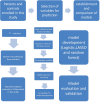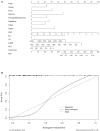Machine learning for screening and predicting the risk of anti-MDA5 antibody in juvenile dermatomyositis children
- PMID: 36703989
- PMCID: PMC9872019
- DOI: 10.3389/fimmu.2022.940802
Machine learning for screening and predicting the risk of anti-MDA5 antibody in juvenile dermatomyositis children
Abstract
Objective: The anti-MDA5 (anti-melanoma differentiation associated gene 5) antibody is often associated with a poor prognosis in juvenile dermatomyositis (JDM) patients. In many developing countries, there is limited ability to access myositis- specific antibodies due to financial and technological issues, especially in remote regions. This study was performed to develop a prediction model for screening anti-MDA5 antibodies in JDM patients with commonly available clinical findings.
Methods: A cross-sectional study was undertaken with 152 patients enrolled from the inpatient wards of Beijing Children's Hospital between June 2018 and September 2021. Stepwise logistic regression, least absolute shrinkage and selection operator (LASSO) regression, and the random forest (RF) method were used to fit the model. Model discrimination, calibration, and decision curve analysis were performed for validation.
Results: The final prediction model included eight clinical variables (gender, fever, alopecia, periungual telangiectasia, digital ulcer, interstitial lung disease, arthritis/arthralgia, and Gottron sign) and four auxiliary results (WBC, CK, CKMB, and ALB). An anti-MDA5 antibody risk probability-predictive nomogram was established with an AUC of 0.975 predicted by the random forest algorithm. The model was internally validated by Harrell's concordance index (0.904), the Brier score (0.052), and a 500 bootstrapped satisfactory calibration curve. According to the net benefit and predicted probability thresholds of decision curve analysis, the established model showed a significantly higher net benefit than the traditional logistic regression model.
Conclusion: We developed a prediction model using routine clinical assessments to screen for JDM patients likely to be anti-MDA5 positive. This new tool may effectively predict the detection of anti-MDA5 in these patients using a non-invasive and efficient way.
Keywords: antiMDA5; antibody; juvenile dermatomyositis; machine learning; pediatric.
Copyright © 2023 Xue, Zhang, Li, Liu, Kuang, Deng, Wang, Tan, Li and Li.
Conflict of interest statement
The authors declare that the research was conducted in the absence of any commercial or financial relationships that could be construed as a potential conflict of interest.
Figures






Similar articles
-
Prediction model for the pretreatment evaluation of mortality risk in anti-melanoma differentiation-associated gene 5 antibody-positive dermatomyositis with interstitial lung disease.Front Immunol. 2022 Sep 23;13:978708. doi: 10.3389/fimmu.2022.978708. eCollection 2022. Front Immunol. 2022. PMID: 36211445 Free PMC article.
-
[Three cases report of juvenile dermatomyositis with positive anti-melanoma differentiation associated gene 5 (MDA5) antibody and severe interstitial lung disease and literature review].Zhonghua Er Ke Za Zhi. 2019 Dec 2;57(12):928-933. doi: 10.3760/cma.j.issn.0578-1310.2019.12.007. Zhonghua Er Ke Za Zhi. 2019. PMID: 31795559 Review. Chinese.
-
A nomogram for the prediction of co-infection in MDA5 dermatomyositis: A rapid clinical assessment model.Clin Immunol. 2025 Mar;272:110431. doi: 10.1016/j.clim.2025.110431. Epub 2025 Jan 20. Clin Immunol. 2025. PMID: 39842682
-
Fatal outcome of anti-MDA5 juvenile dermatomyositis in a paediatric COVID-19 patient: a case report.Mod Rheumatol Case Rep. 2021 Jan;5(1):101-107. doi: 10.1080/24725625.2020.1832755. Epub 2020 Oct 20. Mod Rheumatol Case Rep. 2021. PMID: 33019894 Free PMC article.
-
Adolescent-onset anti-MDA5 antibody-positive juvenile dermatomyositis with rapidly progressive interstitial lung disease and spontaneous pneumomediastinum: a case report and literature review.Pediatr Rheumatol Online J. 2021 Jun 30;19(1):103. doi: 10.1186/s12969-021-00595-1. Pediatr Rheumatol Online J. 2021. PMID: 34193210 Free PMC article. Review.
Cited by
-
An externally validated clinical-laboratory nomogram for myocardial involvement in adult idiopathic-inflammatory-myopathy patients.Clin Rheumatol. 2024 Jun;43(6):1959-1969. doi: 10.1007/s10067-024-06948-x. Epub 2024 Apr 8. Clin Rheumatol. 2024. PMID: 38587715 Free PMC article.
-
Digital Approaches for Myositis.Curr Rheumatol Rep. 2023 Dec;25(12):259-263. doi: 10.1007/s11926-023-01119-4. Epub 2023 Nov 14. Curr Rheumatol Rep. 2023. PMID: 37962833 Free PMC article. Review.
-
Integrating Machine Learning into Myositis Research: a Systematic Review.Clin Rev Allergy Immunol. 2025 Jul 8;68(1):62. doi: 10.1007/s12016-025-09076-9. Clin Rev Allergy Immunol. 2025. PMID: 40624382 Free PMC article. Review.
-
The emerging paradigm in pediatric rheumatology: harnessing the power of artificial intelligence.Rheumatol Int. 2024 Nov;44(11):2315-2325. doi: 10.1007/s00296-024-05661-x. Epub 2024 Jul 16. Rheumatol Int. 2024. PMID: 39012357 Free PMC article. Review.
-
Artificial intelligence-enabled precision medicine for inflammatory skin diseases.ArXiv [Preprint]. 2025 May 14:arXiv:2505.09527v1. ArXiv. 2025. PMID: 40463698 Free PMC article. Preprint.
References
-
- Mendez EP, Lipton R, Ramsey-Goldman R, Roettcher P, Bowyer S, Dye A, et al. NIAMS juvenile DM registry physician referral group. US incidence of juvenile dermatomyositis, 1995–1998: results from the national institute of arthritis and musculoskeletal and skin diseases registry. Arthritis Rheum (2003) 49:300–5. doi: 10.1002/art.11122 - DOI - PubMed
-
- Hamaguchi Y, Kuwana M, Hoshino K, Minoru Hasegawa Kenzo K, Takashi M, Kazuhiro K, et al. Clinical correlations with dermatomyositis-specific autoantibodies in adult Japanese patients with dermatomyositis: A multicenter cross-sectional study. Arch Dermatol (2011) 147:391–8. doi: 10.1001/archdermatol.2011.52 - DOI - PubMed
Publication types
MeSH terms
Substances
Supplementary concepts
LinkOut - more resources
Full Text Sources
Research Materials
Miscellaneous

